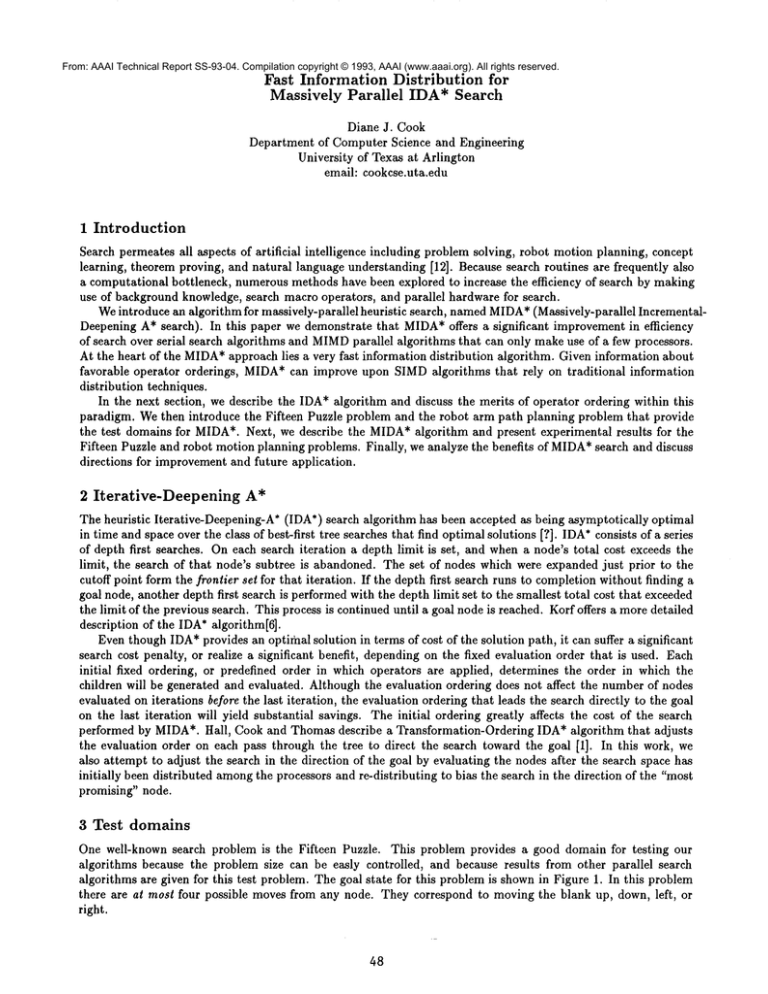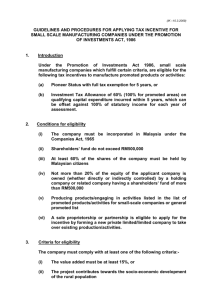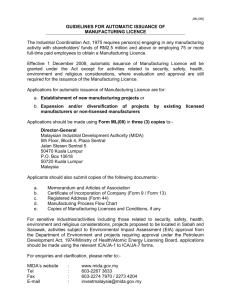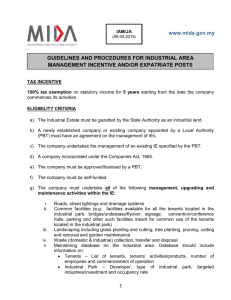
From: AAAI Technical Report SS-93-04. Compilation copyright © 1993, AAAI (www.aaai.org). All rights reserved.
Fast Information Distribution for
Massively Parallel IDA* Search
Diane J. Cook
Department of Computer Science and Engineering
University of Texas at Arlington
email: cookcse.uta.edu
1 Introduction
Search permeates all aspects of artificial intelligence including problem solving, robot motion planning, concept
learning, theorem proving, and natural language understanding [12]. Because search routines are frequently also
a computational bottleneck, numerous methods have been explored to increase the efficiency of search by making
use of background knowledge, search macro operators, and parallel hardware for search.
Weintroduce an algorithm for massively-parallel heuristic search, namedMIDA*(Massively-parallel IncrementalDeepening A* search). In this paper we demonstrate that MIDA*offers a significant improvement in efficiency
of search over serial search algorithms and MIMD
parallel algorithms that can only make use of a few processors.
At the heart of the MIDA*approach lies a very fast information distribution algorithm. Given information about
favorable operator orderings, MIDA*can improve upon SIMDalgorithms that rely on traditional information
distribution techniques.
In the next section, we describe the IDA*algorithm and discuss the merits of operator ordering within this
paradigm. Wethen introduce the Fifteen Puzzle problem and the robot arm path planning problem that provide
the test domains for MIDA*.Next, we describe the MIDA*algorithm and present experimental results for the
Fifteen Puzzle and robot motion planning problems. Finally, we analyze the benefits of MIDA*search and discuss
directions for improvementand future application.
2 Iterative-Deepening
A*
The heuristic Iterative-Deepening-A* (IDA*) search algorithm has been accepted as being asymptotically optimal
in time and space over the class of best-first tree searches that find optimal solutions [?]. IDA*consists of a series
of depth first searches. On each search iteration a depth limit is set, and when a node’s total cost exceeds the
limit, the search of that node’s subtree is abandoned. The set of nodes which were expanded just prior to the
cutoff point form the frontier set for that iteration. If the depth first search runs to completion without finding a
goal node, another depth first search is performed with the depth limit set to the smallest total cost that exceeded
the limit of the previous search. This process is continued until a goal node is reached. Korf offers a more detailed
description of the IDA*algorithm[6].
Even though IDA*provides an optimal solution in terms of cost of the solution path, it can suffer a significant
search cost penalty, or realize a significant benefit, depending on the fixed evaluation order that is used. Each
initial fixed ordering, or predefined order in which operators are applied, determines the order in which the
children will be generated and evaluated. Although the evaluation ordering does not affect the number of nodes
evaluated on iterations before the last iteration, the evaluation ordering that leads the search directly to the goal
on the last iteration will yield substantial savings. The initial ordering greatly affects the cost of the search
performed by MIDA*.Hall, Cook and Thomas describe a Transformation-Ordering IDA* algorithm that adjusts
the evaluation order on each pass through the tree to direct the search toward the goal [1]. In this work, we
also attempt to adjust the search in the direction of the goal by evaluating the nodes after the search space has
initially been distributed amongthe processors and re-distributing to bias the search in the direction of the "most
promising" node.
3 Test domains
One well-known search problem is the Fifteen Puzzle. This problem provides a good domain for testing our
algorithms because the problem size can be easly controlled, and because results from other parallel search
algorithms are given for this test problem. The goal state for this problem is shownin Figure 1. In this problem
there are at most four possible moves from any node. They correspond to moving the blank up, down, left, or
right.
48
Figure 1: The Fifteen Puzzle
In our implementation,each moveis consideredto havea cost of one, so the value of g(n) is equal to the number
of movesmadeto reach node n from the initial state. Weestimate distance to the goal using the Manhattan
Distance Function, whichsumsthe numberof horizontal and vertical grid positions that each tile is fromits goal
position. Thevalue of the heuristic estimate h(n) is the sumof these tile distances.
Another of the manydomainswhichcan benefit from a faster search algorithm is robot arm path planning.
Traditional motion planning methods are very costly whenapplied to a robot arm, because each joint has an
infinite numberof angles it can movefrom each configuration, and because collision checkingmust be performed
for each arm segment with every moveit makes. Because robot arm navigation must be calculated in real time
for general-purposerobot armtasks to be useful, efficient motionplanning is imperative
There exist a variety of algorithmswhichgenerate paths for robot arms [3, 5, 8, 13]. Weutilize the potential
field methodintroduced by Latombe[8]. The workspaceis divided into cells, each of whichis assigned a value
that directs the search for a path toward the goal and awayfrom obstacles. Wecalculate the kinematics for a
Puma560 robot arm with six degrees of freedom. Wemakeuse of the same environment for each tested plan,
but vary the size of the angles and the precision to whichthe goal mustbe reached, in order to test a variety of
search space sizes.
4 The MIDA* Algorithm
The MIDA*
parallel search algorithm is madeup two phases. In the first phase, portions of the search space are
distributed to idle processors (the distribution phase). In the second phase, processors conductIDA*search
their portion of the search space (the search phase). Thedistribution phase biases the search to the left side
the tree, and the search phase continuesthis bias.
4.1 The Distribution
Phase
Onecritical step in parallel search algorithmsis to distribute portions of the search tree to the processors. When
the numberof processors is few distribution does not greatly affect the performanceof the algorithm, but with a
large numberof processors the performancecan be slowedby the task of distributing informationto the processors,
and manyprocessors remain idle until all have the informationthey need to start.
With manyMIMD
and SIMDapproaches, the active processors generate portions of the search space, and
unclaimednodes or newlygenerated nodes are give to idle processors, whothen treat the node as the root of its
ownsearch space [4, 7, 11]. For a large numberof processors, this will result in a long wait by idle processors
while newnodes are generated one by one by active processors.
Thedistribution algorithmused by MIDA*
is central to its performance.Initially, the root of each processor’s
search subtree is empty, but at the end of the distribution phase each will have a board state that represents
the root of a uniquesubtree in the search space. At the beginningof the distribution phase, a single processor
contains the initial board state. A sequence of moves(arranged according to the current evaluation order)
stored in an array. As long as there are enoughemptyprocessors left, the next set of board states is generated
and distributed in the following manner.
Thefirst n active processors copy their board states to a correspondingemptyprocessor, wheren indicates
the either the numberof processors with emptyboard states or the numberof active processors, whicheverhas a
lesser value. Theset of active processors is left untouched.To each newcopy, however,a single moveis made,as
indicated by the current value in the movearray. If there are not enoughprocessors with emptyboard states to
copyall active processors’ information, the leftmost set of active processors are copied, again biasing the search
of the left part of the search space.
Boardstates representing invalid moves(the blank movingbeyondthe board boundaries), board states representing a movecycle of length 2 (the last moveis the opposite of the previous move)and parent states whose
children have all been generatedare tagged for removal. After compressingthe remainingstates, the movecounter
49
movearray
InitialState
Goal State
Iteration:
Processor:
Figure 2: The distribution
phase
is incremented and the process is repeated. Figure 2 illustrates this process for two iterations of the Fifteen Puzzle
problem, where the movearray contains the four possible operators left, down, up, and right
To compress the states, a scan operation is used to incrementally assign unique numbers to all processors
whose current states are not tagged for removal. Once numbered, the boards are copied to the processor of that
number, in effect shifting all valid boards to the left and shifting all removed boards to the right, making the
rightmost processors available for the next iteration. An advantage to this approach is that invalid moves and
parent nodes can be removed with one application of the scan operation, which is an efficient operation on the
Connection Machine. The distribution phase is finished when there are no more empty processors.
Because the order in which operators are applied is not fixed but can be selected using information about
the search problem, we take advantage of this bias to speed up the search process. To do this, we introduce a
modification to MIDA*
in which the distribution phase is executed twice. After the first distribution, the nodes
at this jagged frontier set are evaluated. The node n which is closest to the goal (has the least h(n) value) is
chosen to be the "most promising" node. The evaluation (transformation) order is then changed to reflect a bias
toward that node, in effect shifting that node and its neighbors to the left side of the tree. The distribution phase
is then executed again, after which the search phase begins. This idea of biasing the search toward nodes in the
frontier set with lowest h values is supported by empirical evidence [1, 10].
4.2 The Parallel
IDA* Search Phase
Once the boards are distributed to the processors, each processor can start an IDA*search using its current board
state as the root of its own search subtree. Unlike other SIMDimplementations, our approach does not require
a processor to wait for all others to complete one pass through the search tree before starting a new pass with
a higher threshold. Unlike the approaches presented by Powley et al. [11] and Mahanti and Daniels [9], there is
no load balancing during this phase or between iterations. Instead, each processor searches its unique subtree to
the given threshold. If the tree is completely expanded to that limit without finding a goal node, the processor
starts back at its original board state and searches again to a slightly greater threshold. In our implementation,
each movehas a cost of one and the threshold is incremented by two each pass.
Figure 3 illustrates
the appearance of the expanded search tree just prior to the search phase. Because of
MIDA*’sunique distribution, the tree is explored deeper on the left side of the tree than on the right. As a result,
the processors dedicated to this portion of the tree will finish the early passes more quickly and go on to search
deeper levels.
Note that this search technique heavily biases the search according to the selected operator evaluation order.
If information is supplied that prefers one transformation ordering over another, this approach is ideal. If no such
information is available, this method maybe costly. In fact, Table 1 reveals a wide range of time spent on search
depending on the initial evaluation order.
To determine a evaluation order that looks promising, we modified MIDA*to perform two distribution phases.
After the first distribution, the h values of the nodes that comprise the frontier set are compared. The node with
the lowest h value is picked as the "most promising" node, and the evaluation order is changed so the search will
head in the direction of that node on the next pass.
5O
Figure 3: Expandedtree after distribution
phase
The intuition behind generating a scheme to go quickly to the frontier node with the lowest h value, is that
smaller h values are expected to be more accurate. Powley and Korf offer the analogy of a car being fixed [10]. A
customer feels more confidence about the statement that his car will be ready in 2 days (h = 2) if it has already
sat in the shop 28 days (g = 28) than he would feel about the statement that his car will be ready in 28 days
(h = 28) given that the car has only sat in the shop for two days (g -- 2).
The skewedfrontier set that results from the distribution phase and the resulting deeper thresholds for that
portion of the tree in the search phase bias the search heavily to the left side of the tree. If direction information
is available, it is not necessary to perform load balancing with the intent of movingthe search at equivalent rates
downthrough the tree. As is shownby the results in the next section, there is a big difference between the amount
of search time necessary in the best and worst cases. By adapting the evaluation order, the search proceeds even
more quickly to the goal.
5 Experimental
Results
MIDA*is implemented on a 32K processor Connection Machine 2 (CM2) using the C* language. For the first
test domain, we tested MIDA*on twelve instances of the Fifteen Puzzle problem and tabulated the results. Each
problem instance was run 24 times using all possible initial transformation (operator evaluation) orders. Table
shows the results of the experiments. For each problem instance, we measure the average (A), best (B), and worst
(W) time in seconds to perform the distribution. In addition, we measure the average, best, and worst time
seconds to perform the search, and the number of nodes expanded during this phase (N). Finally, we record the
average number of CMprocessors used to solve the problem instance (P).
Table 2 displays the results of comparingserial IDA*with a parallel MIMD
version of IDA*[2] and our parallel
SIMDimplementation of IDA*on twelve instances of the Fifteen Puzzle used by Korf [6]. The comparison is
based on number of node expansions by each system. Serial IDA* was implemented on a Sun SPARCstation,
the MIMDimplementation of Window-Parallel TOIDA*was run on an 16-processor Intel Hypercube, and the
SIMDimplementation was tested on a Connection Machine 2 with a Sun front end. For the MIMDand SIMD
implementations, the number of node expansions were tabulated for the winning processor (the first processor to
find a solution). WhenMIDA*
is run using a single distribution phase as shown in Table 2, the results indicate
a 3,409% improvement of MIDA*over serial IDA*, and a 197% improvement over MIMDTOIDA*run on 16
processors. The solution depth lies on the average 4 moves beyond the optimal depth, whereas the TOIDA*
solutions lie an average of 16 moves beyond the optimal.
WhenMIDA*is run using two distribution phases with transformation order updating, MIDA*demonstrates
a 8553%improvement over serial IDA*and a 492%improvement over TOIDA*.These figures were calculated by
comparing the number of node expansions to MIDA*.The number of nodes expanded by MIDA*is calculated
as the number of iterations completed during distribution and the number of nodes evaluated by the winning
processor during search.
For the second test domain, we ran MIDA*on a Connection Machine 2 using 8k processors. For this experiment, we compared the performance of MIDA*when applied serially and in parallel to the robot arm path
Puzzle #
18
19
42
47
55
79
85
90
93
94
97
99
Distribution
A
B
11.9 10.4
11.8 10.4
12.1 10.4
11.9 10.4
12.3 10.4
12.9 10.8
11.7 10.7
11.9 10.4
12.0 10.4
13.0 10.4
11.8 10.4
11.8 10.8
Phase
W
12.8
12.7
13.6
13.2
16.2
16.4
12.8
12.9
12.8
12.7
12.9
13.3
Search
A
B
2,093.8 623.0
483.3 48.9
149.4 73.7
649.7 259.8
56.0
9.1
131.3 27.5
193.8 31.7
182.8 41.6
252.1
3.5
44.9 10.8
373.7 108.8
1,631.2 307.4
Phase
W
6,890.7
807.4
354.0
2,587.5
I00.0
300.8
493.0
583.2
875.9
212.6
829.7
5,370.8
Processors
N
77,693
17,754
4,962
24,768
2,134
4,437
5,598
7,012
9,498
1,757
14,432
61,786
P
18,664
17,520
18,636
19,178
19,179
19,330
17,873
18,636
19,179
18,636
18,636
17,668
Table 1: MIDA*
results on all 24 orderings of 12 probleminstances
Korf Puzzle #
18
19
42
47
55
79
85
90
93
94
97
99
Serial IDA* W-P TOIDA*
MIDA*
23,711,067
959,054 21,619
1,280,495
180,951 1,973
877,823
114,960 2,919
1,411,294
361,845 10,042
927,212
163,326
405
540,860
324,289
1,109
2,725,456
642,206
7,626
7,171,137
1,189,296 1,683
1,599,909
57,230
186
1,337,340
115,066
463
1,002,927
152,223 4,277
83,477,694
7,941,556 7,833
Table 2: Comparisonof Serial IDA*, Window-Parallel TOIDA*,and MIDA*
planning problem. To test the algorithm over a variety of search space sizes, we generated robot arm paths with a
number of different
movement angle sizes and desired accuracies. The angle movements range from 5 degrees to 30
degrees, and the goal resolution range from 10 inches to 4 inches. Each problem size was tested and averaged over
three different
goal locations,
and the problems were solved using serial IDA* and MIDA*. The average speedup
over all tested problems, run on an CM2with 8k processors, is 1144%. The actual timings will be included in the
final version of this paper.
When transformation
ordering is invoked, the worst case time performances are improved from 27.6 minutes
to approximately 11 minutes. On the other hand, the average performance does not improve significantly.
Some
of the previous best cases are slowed down a little,
and extra time is needed to perform the second distribution,
thus somewhat equalizing the results.
6 Concluding
remarks
In this paper, weintroduce an algorithm for performingmassivelyparallel IDA*search. Using MIDA*,
the search
space is distributed
among the available processors using a distribution
technique that is very fast and biases
the search toward the left side of the tree. With a two-pass distribution,
the search is actually directed toward
the most favorable portion of the search space. This technique is beneficial when the favorable direction can be
calculated,
and risky when this information is not available. Once the distribution
is complete, each processor
searches for a goal node in its portion of the search space using a set of incrementally-deepening
depth-first
searches.
There are several factors which can make MIDA*a more powerful search technique. First, there is currently
52
no load balancing performed between or during search iterations. Load balancing can improve the search process
by ensuring that each processor is searching a portion of the space which has a high likelihood of containing a
goal node. MIDA*can make use of these techniques to improve performance of the search phase.
Second, a key to MIDA*’sdistribution is the information gained about the transformation order. In the
most drastic case (Problem 93), the worst transformation order has resulted in a Fifteen Puzzle search time 250
times as large as the best order search time. Therefore, evaluation order information must be used prior to the
final distribution. Wemodified MIDA*to perform two distributions. The second distribution uses the preferred
transformation order indicated by the first distribution. Unfortunately, the first distribution does not go far
enough down into the tree to glean enough information. The modification improves the worst case search time,
but overall improvement could be increased by incorporating more information about preferable transformation
orders.
Results indicate that this algorithm can provide an excellent methodof improving the speed of AI applications
by greatly improving the speed of search. As additional information can be incorporated about favorable directions
of search, this speedup is expected to increase.
References
[1] D. J. Cook, L. Hall, and W. Thomas. Parallel search using transformation-ordering
to appear in The International Journal of Intelligent Systems, 1992.
iterative-deepening
a*.
[2] D. J. Cook, L. Hall, and W. Thomas. Parallel search using transformation-ordering
to appear in the International Journal of Intelligent Systems, 1992.
iterative-deepening
a*.
[3] M. R. Jahanbin and F. Fallside. Path planning using a wave simulation technique in the configuration space.
In J. S. Gero, editor, Arlificial Intelligence in Engineering: Robotics and Processes, pages 121-139. Elsevier
Science Publishing, 1988.
[4] L. V. Kale and V. A. Saletore. Parallel state-space search for a first solution with consistent linear speedups.
International Journal of Parallel Programming,19(4):251-293, 1990.
[5] Kant and Zucker. Planning collision-free trajectories in time-varying environments: A two-level hierarchy.
In Proceedings of IEEE International Conference on Robotics and Automation, pages 1644-1649, 1988.
[6] R.. E. Korf. Depth-first iterative
27:97-109, 1985.
deepening: An optimal admissible tree search. Artificial
[7] R. E. Korf. Optimal path-finding algorithms. In L. Kanal.and V. Kumar, editors,
Intelligence, pages 223-267. Springer-Verlag, NewYork, 1988.
Intelligence,
Search in Artificial
search. In Kumar, Kanal, and
[8] V. Kumar and V. N. Rao. Scalable parallel formulations of depth-first
Gopalakrishan, editors, Parallel Algorithms for Machine Intelligence and Vision, pages 1-41. SpringerVerlag, 1990.
[9] J.-C. Latombe. Robot Motion Planning. Kluwer Academic Publishers,
[10] A. Mahanti and C. J. Daniels. A simd approach to parallel
on Parallel Processing for AI, pages 117-127, 1991.
1991.
heuristic search. In Proceedings of the Workshop
[11] C. Powley and R. E. Korf. Single agent parallel windowsearch: A summaryof results.
Conference on Artificial Intelligence, pages 36-41, 1989.
In International Joint
[12] C. Powley, R.. E. Korf, and C. Ferguson. Ida* on the connection machine. In Proceedings of the Workshop
on Parallel Processing for AI, pages 161-168, 1991.
[13] V. N. Rao, V. Kumar, and K. Ramesh. A parallel
of AAAI, pages 178-182, 1987.
implementation of Iterative-Deepening-A*.
In Proceedings
[14] R. F. Richbourg, N. C. Rowe, M. J. Zyda, and R. B. McGhee. Solving global, two-dimensional routing
problem using shell’s law and a* search. In Proceedings of IEEE International Conference on Robotics and
Automation, pages 1631-1636, 1987.
53







